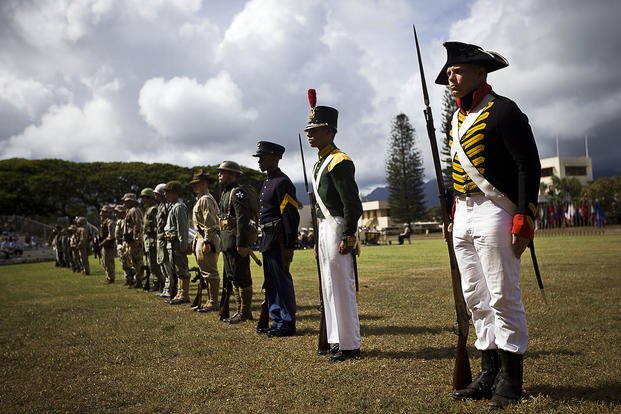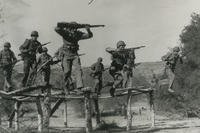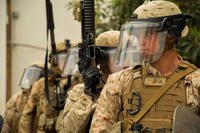With the raising of two battalions by the Continental Congress, the United States Marine Corps came into existence on Nov. 10, 1775. Throughout its long history, the USMC has distinguished itself in part with distinct uniforms. The earliest Marine Corps uniforms were made from green broadcloth. Some accounts argue that green was used because Marines were rifleman, a practice used in European armies. However, the Marines of the late 1700s were not rifleman but musketeers. The simple answer is that green broadcloth was a widely accessible uniform-worthy material at the time.
The iconic dark blue cloth associated with the modern-day Marine Corps didn't appear until 1798. The first official uniform guides required coats made of dark blue broadcloth with red facing. Instead of regular buttons, the coats featured brass naval buttons.
In 1834, the iconic dark blue material came under threat when President Andrew Jackson demanded to bring back green cloth for the Marine Corps. Official uniform guidelines changed, but problems were immediately apparent. The necessary green cloth was scarce, and much of it had to be ordered from Great Britain at exorbitant prices. The dye itself was of poor quality and faded quickly or turned shades of yellow at sea. Despite the frequency and nature of complaints about the green cloth, no changes were made until Andrew Jackson left office. In 1839, the blue and red uniforms were brought back without protest.
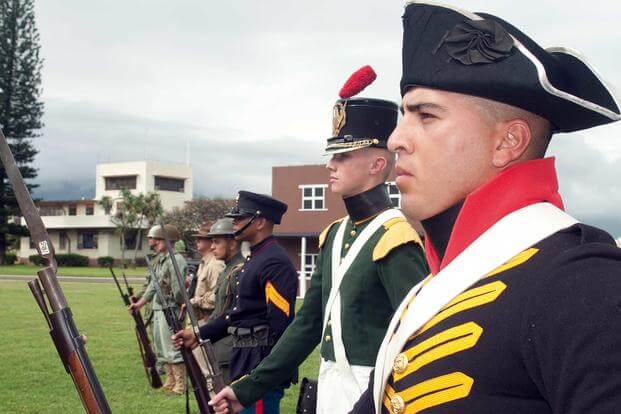
One of the most iconic features of the blue dress uniform is the scarlet blood stripe that runs down the outer seam of each pant leg. This style is reserved for Marines at the rank of corporal and above; the stripe increases in width for officers and general officers. This stripe is subject to much speculation in regard to its origin. The story most commonly handed down from drill instructors to recruits is that it signifies a great sacrifice in the Marine Corps' history. Supposedly, in 1847, the majority of a force of Marines were cut down attempting to storm Chapultepec, a castle in Mexico City. In truth, the blood stripe was introduced in 1834 and was inspired by the Army's decision to match trouser stripes to the color of jacket facings. As for the famous charge, seven Marines died out of about 450.
For less formal occasions when dress blues aren't necessary, Marines wear the service uniform that consists of khaki and green colors. There are minor variations on the service uniform that occur, depending on situation or environment.
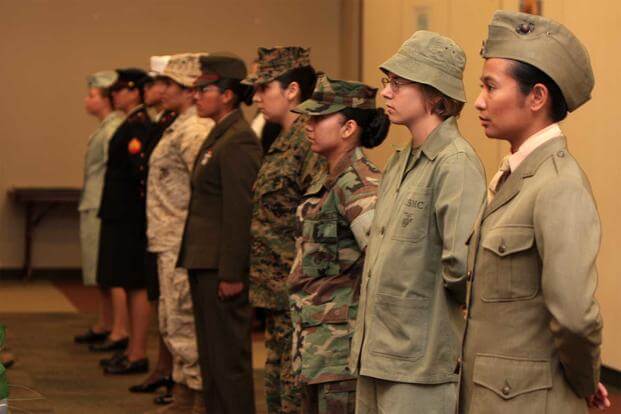
The term leatherneck can be an insult depending on how it's said and who says it, but the term originated from the uniforms worn by Marines in the early years of the Corps' official existence. In order to help keep high collars straight, both enlisted personnel and officers wore a leather stock around their necks. After the Civil War, the stock was removed in place of a strip of black leather affixed to the inside of the uniform's collar. Modern uniforms have done away with leather entirely in favor of a tab of cloth that sits behind the front of the collar.
The iconic globe and anchor came into being in 1868. Brigadier General commandant Jacob Zeilin gathered a board of officers to create a new ornament for caps worn by the Marine Corps. They replaced the bugle that had been in use since 1859 with the now famous globe, eagle and anchor. In 1875, the symbol was adopted as the emblem of the Marine Corps.
Working and garrisoned Marines wear the Marine Corps Combat Utility Uniform (MCCUU). The camouflage pattern not only helps to conceal the wearer, but distinguish them from members of other branches of the military. Marines used to share utility uniforms with the Army but have since adopted their own patterns, which incorporate the eagle, globe and anchor.
Interested in Joining the Military?
We can put you in touch with recruiters from the different military branches. Learn about the benefits of serving your country, paying for school, military career paths, and more: sign up now and hear from a recruiter near you.
